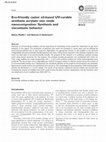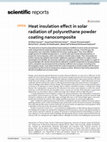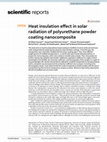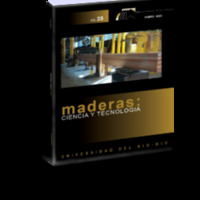Papers by Behzad Shirkavand Hadavand
Environmental Pollution, Sep 1, 2023
Environmental Pollution, Sep 1, 2023
Polymer-plastics technology and materials, Jun 22, 2022
In this study, we are going to produce UV-curable hydrogel hybrids with carbon quantum dots. For ... more In this study, we are going to produce UV-curable hydrogel hybrids with carbon quantum dots. For this purpose, after synthesizing CQDs, they were reacted with acrylic acid to establish covalent bonds and create a C = C bond on the surface of CQDs. Then acrylamide hydrogel was synthesized. In the next step, 1, 3 and 5% UV-curable hydrogel hybrids were prepared. The experimental results displayed that increasing the amount of CQDs in the hydrogel increased photoluminescence intensity and water adsorption while boosting the hydrogel's thermal stability. Besides, increasing the CQDs amount reduces the hydrogel elasticity.
Polymer-plastics technology and materials, Jun 22, 2022
In this study, we are going to produce UV-curable hydrogel hybrids with carbon quantum dots. For ... more In this study, we are going to produce UV-curable hydrogel hybrids with carbon quantum dots. For this purpose, after synthesizing CQDs, they were reacted with acrylic acid to establish covalent bonds and create a C = C bond on the surface of CQDs. Then acrylamide hydrogel was synthesized. In the next step, 1, 3 and 5% UV-curable hydrogel hybrids were prepared. The experimental results displayed that increasing the amount of CQDs in the hydrogel increased photoluminescence intensity and water adsorption while boosting the hydrogel's thermal stability. Besides, increasing the CQDs amount reduces the hydrogel elasticity.
Environmental Pollution, Sep 1, 2023
Polymer-plastics technology and materials, Jun 22, 2022
In this study, we are going to produce UV-curable hydrogel hybrids with carbon quantum dots. For ... more In this study, we are going to produce UV-curable hydrogel hybrids with carbon quantum dots. For this purpose, after synthesizing CQDs, they were reacted with acrylic acid to establish covalent bonds and create a C = C bond on the surface of CQDs. Then acrylamide hydrogel was synthesized. In the next step, 1, 3 and 5% UV-curable hydrogel hybrids were prepared. The experimental results displayed that increasing the amount of CQDs in the hydrogel increased photoluminescence intensity and water adsorption while boosting the hydrogel's thermal stability. Besides, increasing the CQDs amount reduces the hydrogel elasticity.
Materials in engineering, Sep 1, 2013
Materials in engineering, Sep 1, 2013
Materials in engineering, Sep 1, 2013

Journal of Composite Materials, Jun 29, 2019
Attention to environmental problems and the importance of maintaining it have caused the research... more Attention to environmental problems and the importance of maintaining it have caused the researchers to pay more attention in this regard. The production of polymers and resins has increased in recent years and has affected by environmental pollution due to their long-term degradation. An appropriate solution to this problem is the synthesis of degradable and environmentally friendly polymers and resins. Using natural materials in the synthesis of polymers and resins can help them to be environmentally friendly. The purpose of this research is to synthesize urethane acrylate resins using natural resources. For this purpose, the urethane acrylate pre-polymer was synthesized with castor oil. Then, using modified zinc oxide nanoparticles with 1, 3 and 5 wt% urethane acrylate zinc oxide nanocomposites were produced. The use of castor oil as a degradable part and lack of organic solvent in radiation systems led to the creation of an environmentally friendly resin. Subsequently, the viscoelastic behavior of the prepared nanocomposite was evaluated. Spectrometry results confirm the synthesized resin structure. The morphology of nanocomposites confirmed the proper particle size distribution in a 3 wt.% sample. The results of the dynamic mechanical thermal analysis test showed that increasing the amount of modified nano ZnO could increase the glass transition temperature, and the maximum value was observed in 5 wt.% modified nano ZnO (69.7 C).

Journal of Composite Materials, Jun 29, 2019
Attention to environmental problems and the importance of maintaining it have caused the research... more Attention to environmental problems and the importance of maintaining it have caused the researchers to pay more attention in this regard. The production of polymers and resins has increased in recent years and has affected by environmental pollution due to their long-term degradation. An appropriate solution to this problem is the synthesis of degradable and environmentally friendly polymers and resins. Using natural materials in the synthesis of polymers and resins can help them to be environmentally friendly. The purpose of this research is to synthesize urethane acrylate resins using natural resources. For this purpose, the urethane acrylate pre-polymer was synthesized with castor oil. Then, using modified zinc oxide nanoparticles with 1, 3 and 5 wt% urethane acrylate zinc oxide nanocomposites were produced. The use of castor oil as a degradable part and lack of organic solvent in radiation systems led to the creation of an environmentally friendly resin. Subsequently, the viscoelastic behavior of the prepared nanocomposite was evaluated. Spectrometry results confirm the synthesized resin structure. The morphology of nanocomposites confirmed the proper particle size distribution in a 3 wt.% sample. The results of the dynamic mechanical thermal analysis test showed that increasing the amount of modified nano ZnO could increase the glass transition temperature, and the maximum value was observed in 5 wt.% modified nano ZnO (69.7 C).
Fullerenes Nanotubes and Carbon Nanostructures, Jun 22, 2023
Fullerenes Nanotubes and Carbon Nanostructures, Jun 22, 2023
Polymer-Plastics Technology and Materials
ABSTRACT This study aims to investigate the reinforcing effects of graphene quantum dots on vario... more ABSTRACT This study aims to investigate the reinforcing effects of graphene quantum dots on various properties of epoxy resins. To do this, graphene quantum dots were synthesized, then, characterized by various spectroscopic methods. These nanoparticles including several weight percentages along with a curing agent were added to epoxy resin. Finally, fluorescent epoxy graphene quantum dots nanocomposites were prepared. FTIR, photoluminescence, UV-visible absorption, FESEM, TGA, tensile testing and DMTA analysis were used to characterize the resultant nanocomposites. Findings evinced that adding graphene quantum dots to the epoxy resin led to an improvement of thermal stability, mechanical features, and viscoelastic properties of nanocomposites. Graphical abstract
Polymer-Plastics Technology and Materials
ABSTRACT This study aims to investigate the reinforcing effects of graphene quantum dots on vario... more ABSTRACT This study aims to investigate the reinforcing effects of graphene quantum dots on various properties of epoxy resins. To do this, graphene quantum dots were synthesized, then, characterized by various spectroscopic methods. These nanoparticles including several weight percentages along with a curing agent were added to epoxy resin. Finally, fluorescent epoxy graphene quantum dots nanocomposites were prepared. FTIR, photoluminescence, UV-visible absorption, FESEM, TGA, tensile testing and DMTA analysis were used to characterize the resultant nanocomposites. Findings evinced that adding graphene quantum dots to the epoxy resin led to an improvement of thermal stability, mechanical features, and viscoelastic properties of nanocomposites. Graphical abstract
Case Studies in Thermal Engineering
Case Studies in Thermal Engineering

Scientific Reports
This study aims to improve polyurethane-based coating by modified zirconium oxide and aluminum ox... more This study aims to improve polyurethane-based coating by modified zirconium oxide and aluminum oxide nanoparticles for preparing thin polymeric heat insulation coatings. In the first step, the nanoparticles were chemically modified with the silane coupling agent. Then, three different weight percent of modified nanoparticles (1, 3, and 5% w/w) were mixed with polyurethane, to prepare the nanocomposites, which were coated on metallic plate samples. Then, these plates are used to measure the radiation heat transfer coefficients, absorption coefficient in a region of short wavelengths (UV/VIS/NIR), the emissivity coefficient, and thermography of the samples in a region of long wavelengths (IR). Results showed that by adding the modified nanoparticles to the polyurethane matrix, absorption was decreased and the emissivity coefficient was increased. According to the thermography results, it was observed that the surface temperature of both samples with 3% w/w of nanoparticles had the min...
Chemical Engineering of Polymers, 2017

Scientific Reports
This study aims to improve polyurethane-based coating by modified zirconium oxide and aluminum ox... more This study aims to improve polyurethane-based coating by modified zirconium oxide and aluminum oxide nanoparticles for preparing thin polymeric heat insulation coatings. In the first step, the nanoparticles were chemically modified with the silane coupling agent. Then, three different weight percent of modified nanoparticles (1, 3, and 5% w/w) were mixed with polyurethane, to prepare the nanocomposites, which were coated on metallic plate samples. Then, these plates are used to measure the radiation heat transfer coefficients, absorption coefficient in a region of short wavelengths (UV/VIS/NIR), the emissivity coefficient, and thermography of the samples in a region of long wavelengths (IR). Results showed that by adding the modified nanoparticles to the polyurethane matrix, absorption was decreased and the emissivity coefficient was increased. According to the thermography results, it was observed that the surface temperature of both samples with 3% w/w of nanoparticles had the min...










Uploads
Papers by Behzad Shirkavand Hadavand